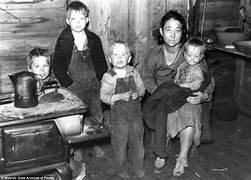The Great Depression and the New Deal
The Great Depression was the most severe economic crisis in American history. It began in October 1929 with the catastrophic collapse of the stock market, wiping out fortunes overnight and setting off a chain reaction of bank failures, business closures, and mass unemployment. By 1933, more than 15 million Americans were out of work and nearly half the nation's banks had failed. America’s booming economy of the 1920s gave way to deep uncertainty and despair.
Farmers faced plunging crop prices, and many lost their land. Urban families struggled to pay rent and feed their children. Breadlines stretched for blocks. Hobos rode freight trains across the country seeking work. The Dust Bowl worsened the crisis for Midwesterners, as years of drought and poor soil management caused massive dust storms that displaced thousands of farming families, many of whom migrated west with little more than hope.
In 1932, the American people elected Franklin D. Roosevelt, who promised a "New Deal" for the American people. Roosevelt brought optimism, energy, and a sweeping agenda to Washington. He wasted no time — during his first 100 days in office, he introduced a flurry of legislation aimed at stabilizing the economy, providing relief, and preventing future depressions. Roosevelt closed banks temporarily to stop the panic, created government jobs, and launched ambitious public works projects.
Programs like the Civilian Conservation Corps (CCC), Public Works Administration (PWA), and Works Progress Administration (WPA) gave millions of Americans jobs building roads, schools, parks, and bridges. The Tennessee Valley Authority (TVA) brought electricity and economic development to rural areas. The Social Security Act of 1935 established pensions for the elderly, unemployment insurance, and aid for dependent children and the disabled — a foundational shift in how America cared for its citizens.
The New Deal redefined the role of the federal government. For the first time, Washington took direct responsibility for ensuring economic stability and social welfare. Labor unions gained new rights, financial markets were more closely regulated, and Americans began to look to the federal government for protection against the boom-and-bust cycles of the past. Roosevelt’s leadership helped to restore hope and confidence, even when challenges remained.
Despite its successes, the New Deal was not without controversy. Conservatives accused Roosevelt of expanding government power too far, while some progressives argued he didn’t go far enough in addressing systemic poverty and racial inequality. The Supreme Court initially struck down several New Deal programs, leading FDR to propose expanding the Court — a move that sparked political backlash but ultimately led to more favorable rulings for his policies.
African Americans, while often excluded from some New Deal programs due to discrimination, began to shift political allegiance to the Democratic Party because of Roosevelt's outreach and initiatives. Women, too, found new roles in government and the workforce. First Lady Eleanor Roosevelt redefined the role of First Lady, becoming a powerful advocate for civil rights, women’s rights, and social justice across the country.
Though the New Deal did not end the Depression outright, it laid the groundwork for recovery and set the stage for America's economic mobilization during World War II, which would ultimately bring prosperity back. More importantly, the New Deal left a legacy of reforms and public institutions that shaped modern American life — from Social Security to federal work programs to regulatory agencies like the SEC and FDIC.
The Great Depression and the New Deal era represent a turning point in American history — a time when ordinary Americans demanded action, and when bold leadership answered that call. It reminds us that even in the most uncertain times, our democratic system, when energized by the people, can rise to meet any challenge. Today, the New Deal serves as a benchmark for how we respond to national crises with resilience, courage, and innovation.

